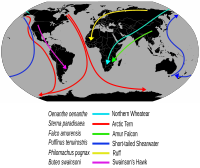
Photo from wikipedia
Migration is a dynamic process, difficult to frame and even harder to predict. Unlike other key events (most specifically death), migration follows uncertain pathways and reflects securities and insecurities that… Click to show full abstract
Migration is a dynamic process, difficult to frame and even harder to predict. Unlike other key events (most specifically death), migration follows uncertain pathways and reflects securities and insecurities that tend to play out across diverse social landscapes and include movers, non-movers as well as households and communities. Nevertheless, as the articles in this volume of Migration Letters reveal we continue to explore migration and its history; model decision-making and the challenges that movers face as they select new pathways; and explore as well as predict outcomes of remittance practices, policymaking and status. The articles in this issue and throughout our journal are often focused on what Tomas Faist (and others) call the crucial meso-level (Faist 1997). This is the space where the decisions of individuals encounter and engage the household and other movers as well as non-movers, the community and the state. The encounters and engagements that occur at the meso-level remind us that migration is not a simple decision, made by an independent actor. Rather, the decisions to move—whether as a migrant or refugee; whether across an international border or across a town—are complex and include many different voices, challenges and trials.
Journal Title: Migration Letters
Year Published: 2018
Link to full text (if available)
Share on Social Media: Sign Up to like & get
recommendations!